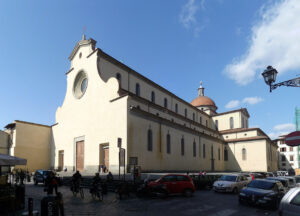The proposed path starts from the right aisle, where we immerse ourselves in a walk of knowledge and spirituality under the banner of artists such as Pier Francesco Foschi, Jacopo Sansovino, Giovanni Baratta and many others. The alternation in the altars of paintings, marble decorations and reliefs of admirable workmanship accompany us throughout the entire journey. Moving along the right transept we find ourselves in front of eight chapels placed according to a classical architectural scheme, two for each minor side and four on the right side. The work that stands out at first glance and certainly located in the Nerli Chapel. The Nerli Altarpiece (Madonna with Child and Saints Giovannino, Martino and Caterina d’Allesandria) by Filippo Lippi, which depicts a view of the historic district of San Frediano, is certainly one of the most famous works inside the Basilica. Continuing along the path we come across one of the most majestic chapels of the Basilica, that of the Frescobaldi, Cini, Dainelli da Bagnano. Inside there are the altarpiece of Christ and the Adulteress by Alessandro Allori, signed and dated 1577, with the portrait of the Da Bagnano family in the predella. The paliotto belongs to the XVI century and the round stainglass on top had been made at the end of the XV century. In the upper left, there is an eighteenth-century choir thanks to which the Frescobaldi marquises could participate in the liturgy from their private palace adjacent to the church, without being seen by the people. Next to the capocroce, the area behind the altar which includes the choir and the apse, we come across the Corbinelli Chapel, which shows all the refinement and virtuosity of Andrea Sansovino with the union of architecture and sculpture.
Elegant pilasters, decorated with candelabra between three niches, recall the Roman triumphal arches. In the central niche there is a tabernacle in the shape of an aedicule that shows, in bas-relief, the Risen Christ on the door. In the side niches there are the statues of Saint Matthew and Saint James, surmounted by the tondo with the Archangel Gabriel and the Virgin announced. The path inside the Basilica ends with the left aisle that houses works by artists of the stature of Michele di Ridolfo del Ghirlandaio, Taddeo Landini up to Pier Francesco Foschi, with which we conclude our walk inside the Basilica. The monumental complex of Santo Spirito also offers an exclusive space dedicated to the Augustinian path (museum), whose entrance is located under the organ, that with its sacred melodies pervades the suggestive space of the Basilica and floods the access to the vestibule of the sacristy.
The Augustinian Museum of Santo Spirito
The Augustinian path begins by lighting the vestibule, which retains a valuable coffered ceiling made by Andrea Sansovino in 1491. Entering the vestibule appears a glimpse of the sacristy. A quick look inside is enough to be captivated by the architectural simplicity that fills the mind and spirit with a sense of peace. The octagonal plan and the decorations in pietra serena and plaster reflect the talent of the architect, Giuliano da Sangallo. The Renaissance style broadens the perception of spaces, although the visitor is in a small room, the feeling of constriction given the proximity of the walls is greatly reduced. The pilasters supporting the octagon do not tire the observer, but surprise with every contrast, thanks to the Corinthian capitals that show scenes always changing as decorations. Here one of the works of pride of the monumental complex of Santo Spirito stands before us. The Wooden Crucifix of a young Michelangelo, although the composition represents a rather frail and defenseless icon before the drama of martyrdom and death, the location inside the sacristy gives it a state of grandeur and splendor, as if it were part of the structure. His centrality places him as the backbone of the entire space: the Christ suffocated by the sufferings of martyrdom, is freed from any constriction and placed in the center of the sacristy at half height as if it were almost an apparition, ready to interact with those who trust in him.
Finally, the path leads us to the cloister of the Dead, so called for the large number of tombstones that crowd the walls. Square structure, with seven round arches on each side, supported by massive square pillars, which extend to the upper floor in pilasters framing the windows in succession. Each arch corresponds to a lunette decorated in the eighteenth century by various artists. But the beauty of the place is not limited to what the eyes see: at a certain point blindness pervades the soul and man discovers infinite relationships that dissolve his loneliness. The look is no longer enough to understand the sacred place in front of you, the body and soul must let go to become aware of an environment out of time. Here the soul seeks peace and moments far from the constraints of normal life.








